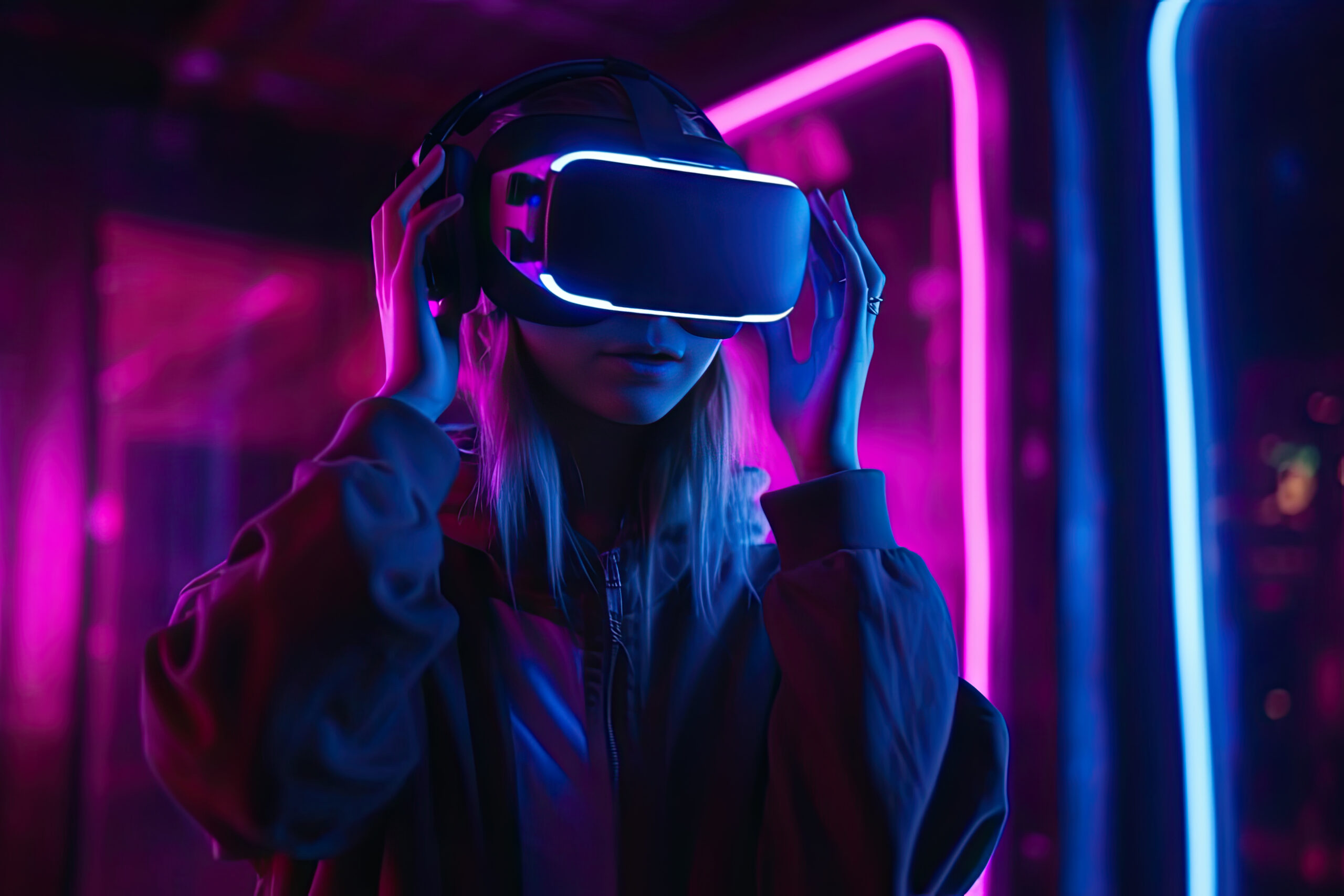Metaverse
The Metaverse is a digital environment that combines augmented and virtual reality and permeates the Internet. It provides users with an interactive, multi-dimensional environment in which they can create and explore.
This cutting-edge environment goes beyond what is possible in normal reality, allowing users to interact with intelligent avatars, explore bizarre landscapes and go on amazing adventures. The Metaverse is a paradigm shift that offers an exciting explosion of invention where reality and imagination blend into a visionary world of creative possibility.
Click Here: Best Metaverse Development Solutions Company
What Is Metaverse?
Built on a blockchain development technological basis, Metaverse is a spatial computing platform that provides virtual experiences that mimic or replace the actual world, complete with key components of civilization like trade, social interactions, money, economy, and property ownership.
Through a headset, a smartphone app, or a website in the metaverse, one can access a variety of three-dimensional worlds. Over long distances, anyone can take part and experience this in real time. An enormous online application ecosystem will be the end product.
The Metaverse is currently all the rage in the digital world because of its seemingly endless possibilities and aspirations. Because Metaverse is at the forefront of technological and digital breakthroughs, it draws a lot of investors.
History of the Metaverse
Through the archives of the digital world, there is this mysterious thing called the “Metaverse.” This conceptual construct has captured the collective imagination of cybernauts worldwide, brimming with complexity and multiple subtleties.
The Metaverse is a metaphor of confusion itself, with its intricate web of linked virtual realms. It defies reality’s rules and immerses users in an incredible plethora of synthetic experiences, transcending the mundane and embracing the extraordinary.
A vivid explosion of variation coexisting inside the controlled boundaries of a virtual cosmos is the metaverse’s alluring paradox. The Metaverse’s reputation as a hub for creativity and invention has been cemented by this dynamic oscillation between minute precision and unbridled imagination.
Contrary to the uniformity inherent in AI-generated landscapes, the Metaverse thrives on burstiness, adorning itself with sentences both terse and expansive. This divergence from the AI’s characteristic consistency imbues the Metaverse with a unique appeal that resonates with the human penchant for narrative variety.

How To Access The Metaverse
First and foremost, the platforms and technologies available determine how one can access the metaverse. There are multiple virtual worlds and habitats, not one cohesive metaverse, as of my latest information update in September 2021. However, here is the general procedure for entering the metaverse:
- Select Platform: Select a virtual world or metaverse platform. These may be social media platforms, online games, virtual reality (VR) environments, or even blockchain-based metaverses.
- Software and Hardware: Make sure you have the necessary software and hardware. Depending on platform requirements, this could be a VR headset, a powerful PC, or a mobile device.
- Create an Account: Sign up for an account on the selected platform. Usually, you need to create a login and provide some personal data.
- Install App: If required, download and set up the client or platform app on your device. VR applications, game clients, or custom metaverse software are some examples.
- Personalise Your Avatar: You can create a digital representation of yourself in many metaverse scenarios. Make your avatar look the way you want.
- Explore and Interact: Take a look around the metaverse as soon as you log in. Engage in activities, communicate with others, and explore the virtual environment.
How Does the Metaverse Work?
The Metaverse is a digital cosmos made up of connected virtual worlds that users can explore and interact with by creating avatars. These verbal, nonverbal, and gestural exchanges promote community building and socialisation.
In addition, many metaverse environments have their own digital markets where users can exchange virtual goods. To guarantee ownership and scarcity, these markets often use blockchain technology.
- Virtual Worlds: Users can traverse and participate in a network of interconnected virtual worlds, or digital places, that form a metaverse. While 2D settings, augmented reality, and even fully text-based experiences can be found in this world, 3D game development environments are the most common type.
- Avatar: An avatar is a digital image that is usually created by the user themselves. Users can explore virtual environments, talk to other users, and interact with them using these avatars.
- Interactivity: A key component of metaverse design. In virtual reality, users can talk to each other through voice, text, or even gestures. Additionally, they can interact with the environment by producing, modifying, or exchanging digital goods.
- Economy: The virtual economy is a feature of many systems in the metaverse. Digital assets can be bought, sold, and exchanged by users; ownership and scarcity are often guaranteed by blockchain technology. This includes in-game exclusives, avatar clothing, and virtual real estate.
- Socialization: Fundamental feature of the metaverse. To replicate social interactions in the real world, users can attend events, join communities, and engage in various forms of social interaction.
How Is The Metaverse Different From The Internet?
The internet and the metaverse are two different but related ideas. The Internet is a worldwide network of interconnected servers and computers, mostly used for online activities, communication, and information exchange.
It is a network of websites, social media, email, and other services that support the modern digital world. Metaverse, on the other hand, is a segment of the internet dedicated to building interactive, networked virtual environments and worlds where users interact with each other through avatars.
The metaverse is a 3D or immersive space intended for social interactions, digital commerce, and interactive experiences, whereas the internet is largely a 2D place for information and communication. Metaverse simulates real-world interactions and settings using technologies such as virtual reality and augmented reality.

Metaverse VS. The Internet
Here’s a comparison of the metaverse and the internet:
| Aspect | Metaverse | Internet |
|---|---|---|
| Nature | Immersive 3D or virtual environments | Vast global network of interconnected computers and servers |
| User Interaction | Avatars, socialization, real-time interaction | Browsing websites, information access, communication |
| Design | Focused on shared experiences, social interactions, digital commerce | Information-centric, website-based |
| Medium | Utilizes VR, AR, and emerging technologies | Primarily 2D web pages, apps |
| Function | Simulates real-world interactions and environments | Information exchange, communication, access to online services |
| Data | Often generates user data through interactions | User-generated content, data exchange |
| Scope | Smaller subset of the internet, focused on immersive experiences | Global network connecting diverse online services |
| Evolution | Continues to evolve with new technologies, blurring lines with the internet | A mature technology, continues to evolve with new applications |
This table highlights the main differences between the Internet and the metaverse, as well as their respective purposes, interfaces, and methods of use. He also acknowledges that the lines separating the two realms are becoming increasingly blurred as more Internet services are included in the metaverse.
Conclusion
The Metaverse is an intricate web of linked virtual worlds that defies easy explanation, providing access to a wide range of artificial realities that push the envelope of what is possible. It embodies an alluring paradox: an explosion of diversity alternating between unrestrained creativity and exquisite detail while coexisting within the controlled boundaries of a virtual universe.
The Metaverse, in contrast to AI-generated landscapes, is characterised by its burstiness, with both short and long phrases embellishing its surfaces. This break from AI’s usual monotony gives the Metaverse a distinct charm that appeals to people’s appreciation of a wide variety of storylines.
FAQs
Q1: What are some examples of Metaverse?
Some prominent examples of the Metaverse include:
- Roblox: A platform where users create and participate in user-generated 3D worlds and games.
- Decentraland: A blockchain-based virtual world where users can buy, sell, and build on virtual land parcels.
- Fortnite: A popular game that hosts live events, concerts, and social interactions within its virtual universe.
- Facebook Horizon Workrooms: A collaborative VR space for remote work and meetings.
- Minecraft: A sandbox game where players build and explore blocky, virtual worlds.
Q2: How does Metaverse work in the future?
The future of the Metaverse hinges on the convergence of advanced technologies like virtual reality, augmented reality, and blockchain. Users will create avatars to explore interconnected 3D virtual worlds, engaging in social interactions, digital commerce, and immersive experiences. Blockchain will ensure ownership and scarcity of virtual assets, while AI will enhance user experiences, making the Metaverse an intricate, interconnected digital universe.
Read More Blog:
Best Cakephp Development Company in India [2023]
What is Flutter Developer | Flutter Developer Salary in India
More Blogs You May Like
- How to Optimize Mobile Apps for Speed and Performance?
- Flutter: Revolutionizing Best Cross-Platform App Development
- Will ChatGPT take the jobs of Best Web Developers?
- What is Flutter Developer | Flutter Developer Salary in India
- Top iPhone App Development Companies in India
- Top Generative AI Company- Netleon
- News Website Development Company in India
- Best Digital Transformation about Consumers Behaviour
- 5 Reasons to Choose Python for Mobile App Development
- Best 9 Tools You Need to Know for Full-Stack Development


